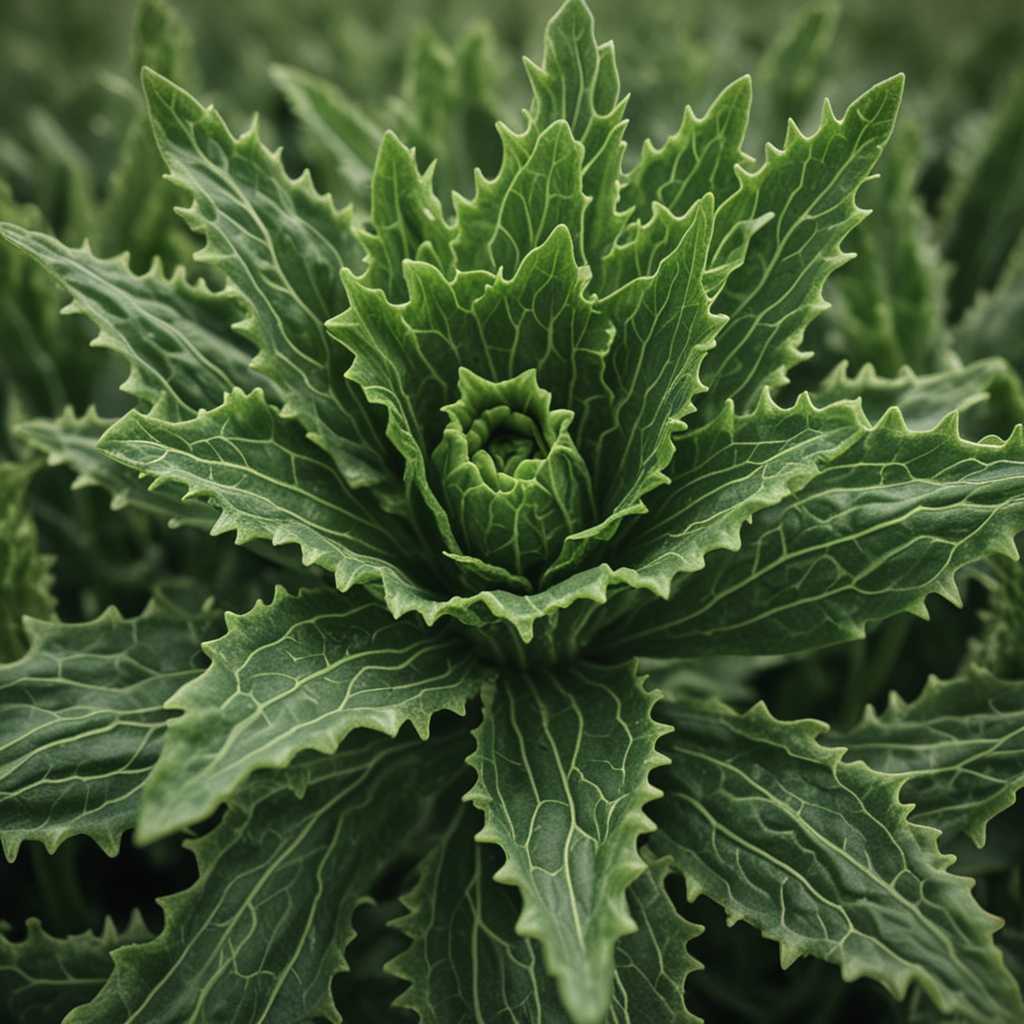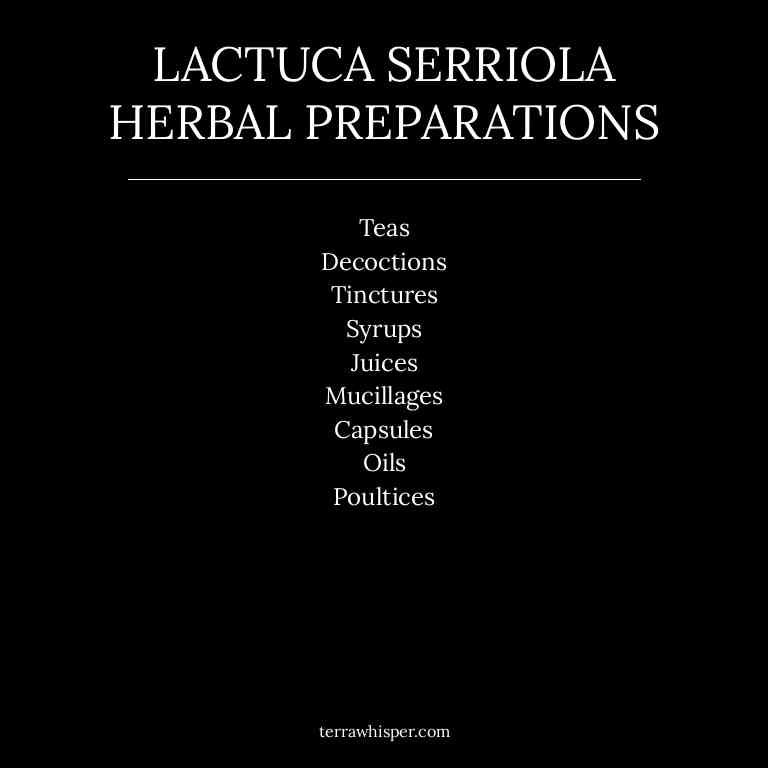Lactuca Serriola Uses, Benefits, And Remedies

Lactuca serriola, commonly known as prickly lettuce, is a wild plant belonging to the Asteraceae family, characterized by its hairy stems and edible leaves.
This herb has been traditionally used for its calming and sedative properties, offering benefits such as stress relief, improved sleep, and mild pain reduction.
The bioactive constituents responsible for its therapeutic actions include sesquiterpene lactones, flavonoids, and alkaloids, which contribute to its anti-inflammatory and anxiolytic effects.
Herbal preparations such as infusions, tinctures, and decoctions can be made from its leaves and flowers to harness its medicinal properties.
This page analize the most important medicinal aspects of Lactuca serriola.
- Health Benefits
- Bioactive Constituents
- Medicinal Parts
- Herbal Preparations
- Side Effects of lactuca serriola
Health Benefits
Lactuca serriola fights infections due to its high concentration of bioactive compounds, including alkaloids and flavonoids, which possess antimicrobial properties that inhibit the growth of harmful bacteria and viruses.
It eases digestion by stimulating the production of digestive enzymes and promoting the secretion of gastric juices, which aid in the breakdown of food and improve nutrient absorption. It has anti-bacterial properties because it contains compounds that disrupt the cell walls of bacteria, preventing their replication and spread within the body. It heals wounds by promoting tissue regeneration and reducing inflammation through the presence of antioxidants and anti-inflammatory agents.
It treats diarrhea by reducing intestinal inflammation and regulating gut motility, helping to restore normal bowel function and prevent dehydration.
The 10 best health benefits of Lactuca serriola are shown in the image below.

The list below give a brief description of the 10 best health benefits of Lactuca serriola.
- Fights Infections: Lactuca serriola contains compounds that help strengthen the immune system and combat various bacterial and viral infections.
- Eases Digestion: It aids in improving digestive health by promoting the secretion of digestive enzymes and reducing gastrointestinal discomfort.
- Has Anti-Bacterial: The herb possesses natural anti-bacterial properties that help in preventing the growth of harmful bacteria in the body.
- Heals Wounds: Lactuca serriola has wound-healing properties that accelerate tissue repair and reduce the risk of infection in injured areas.
- Treats Diarrhea: It helps in alleviating diarrhea by regulating bowel movements and reducing intestinal inflammation.
- Removes Parasites: The herb is known to expel intestinal parasites due to its natural antiparasitic compounds.
- Reduces Stress: Lactuca serriola has calming effects that help reduce anxiety and promote a sense of well-being.
- Reduces Inflammation: It contains anti-inflammatory compounds that help reduce swelling and pain in inflamed tissues.
- Fights Fungal: The herb exhibits antifungal properties that help combat fungal infections such as athlete's foot and ringworm.
Bioactive Constituents
Lactuca serriola carbohydrates play a significant role in its nutritional profile, contributing to its overall caloric value and providing energy for metabolic processes.
In addition to carbohydrates, this herb contains lipids, which are essential for cell membrane structure and the absorption of fat-soluble vitamins. The presence of flavonoids in Lactuca serriola contributes to its antioxidant properties, helping to neutralize free radicals and reduce oxidative stress in the body. Phenolic acids further enhance the herb's medicinal value by exhibiting anti-inflammatory and antimicrobial activities, which support its traditional use in treating various ailments.
Together, these constituents make Lactuca serriola a valuable plant in herbal medicine, offering potential therapeutic benefits for conditions ranging from inflammation to digestive disorders.
The 13 best bioactive constituents of Lactuca serriola are shown in the image below.

The list below give a brief description of the 10 best bioactive constituents of Lactuca serriola.
- Carbohydrates: Carbohydrates are organic compounds composed of carbon, hydrogen, and oxygen, primarily serving as an energy source for the body.
- Lipids: Lipids are a diverse group of organic compounds that include fats, oils, and waxes, functioning as energy storage and structural components in cell membranes.
- Flavonoids: Flavonoids are a group of plant secondary metabolites with antioxidant properties, known for their potential health benefits and role in plant defense mechanisms.
- Phenolic Acids: Phenolic acids are organic compounds with antioxidant properties, commonly found in plants and known for their potential anti-inflammatory and antimicrobial effects.
- Fatty Acids: Fatty acids are essential components of lipids, serving as a primary energy source and playing a crucial role in cell membrane structure and function.
- Lignans: Lignans are a class of polyphenolic compounds found in plants, known for their antioxidant and potential anti-cancer properties.
- Terpenes: Terpenes are a large and diverse class of organic compounds, often responsible for the aromatic properties of plants and having various biological activities.
- Sterols: Sterols are a type of lipid with a ring structure, found in cell membranes and playing roles in cell membrane fluidity and hormone synthesis.
- Saponins: Saponins are plant-derived compounds that have surfactant properties, often used in traditional medicine for their potential anti-inflammatory and antimicrobial effects.
- Glycosides: Glycosides are compounds consisting of a sugar molecule bonded to a non-sugar component, often found in plants and having various medicinal properties.
- Sesquiterpenes: Sesquiterpenes are a class of terpenoids with three isoprene units, known for their aromatic properties and potential pharmacological activities.
- Triterpenoids: Triterpenoids are a class of natural compounds composed of six isoprene units, often found in plants and possessing various biological activities including anti-inflammatory effects.
- Carotenoids: Carotenoids are pigments found in plants, responsible for their vibrant colors, and known for their antioxidant properties and role in vision and immune function.
Medicinal Parts
Lactuca serriola leaf has been traditionally used in herbal medicine for its potential anti-inflammatory and analgesic properties.
The leaves contain compounds such as lactucin and lactucopicrin, which are known to have sedative and pain-relieving effects. These compounds may help in reducing inflammation and alleviating symptoms of conditions like arthritis or muscle pain.
In addition, the leaves are sometimes used to treat digestive issues, such as indigestion and gastrointestinal discomfort, due to their mild laxative properties. The leaf is also believed to have some antimicrobial effects, making it useful in treating minor infections or skin conditions.
While research on its medicinal applications is still ongoing, the traditional use of Lactuca serriola leaf highlights its potential as a valuable herbal remedy in various health contexts.
Herbal Preparations
Lactuca serriola teas are traditionally prepared by steeping dried leaves or flowers in hot water, often used to soothe digestive issues and promote relaxation.
Decoctions, which involve boiling the plant material for a longer period, are preferred for extracting more potent compounds, particularly for treating inflammation or skin conditions. Tinctures made from Lactuca serriola are popular for their concentrated form, offering ease of dosing and longer shelf life, often used for muscle pain or sleep disorders.
Syrups and juices are also made, especially for their mild flavor and ease of consumption, particularly among children or those with sensitive palates. Additionally, mucillages, oils, capsules, and poultices are used in various formulations to target specific ailments, with poultices being particularly effective for topical applications like reducing swelling or treating wounds.
Each preparation method leverages the plant's unique properties, making it a versatile herbal remedy in traditional medicine.
The 10 best herbal preparations of Lactuca serriola are shown in the image below.

The list below give a brief description of the 10 best herbal preparations of Lactuca serriola.
- Teas: Lactuca serriola teas are used to alleviate digestive issues, reduce inflammation, and promote relaxation due to their mild sedative properties.
- Decoctions: Lactuca serriola decoctions are employed to address respiratory conditions, such as coughs and bronchitis, and to support detoxification processes in the body.
- Tinctures: Lactuca serriola tinctures are utilized for their calming effects, helping to relieve anxiety, insomnia, and nervous tension.
- Syrups: Lactuca serriola syrups are used to soothe sore throats, reduce coughing, and provide relief for respiratory discomfort.
- Juices: Lactuca serriola juices are consumed to support digestive health, reduce inflammation, and provide a natural source of nutrients and antioxidants.
- Mucillages: Lactuca serriola mucillages are used to soothe irritated mucous membranes, aid in digestion, and act as a natural demulcent for the throat and stomach.
- Capsules: Lactuca serriola capsules are taken to support digestive wellness, reduce inflammation, and promote a sense of calm and relaxation.
- Oils: Lactuca serriola oils are applied topically to relieve skin irritations, reduce inflammation, and promote healing of minor wounds and abrasions.
- Poultices: Lactuca serriola poultices are used externally to reduce inflammation, soothe skin conditions, and provide relief for muscle aches and joint pain.
Side Effects of lactuca serriola
Lactuca serriola leads to allergic reactions in some individuals, manifesting as symptoms such as skin rashes, redness, and itching.
These reactions are often triggered by contact with the plant's leaves or by ingesting its parts, which can cause a range of dermatological issues. The herb may also induce skin blisters and irritation, making it a potential irritant for sensitive skin.
Eye irritation and redness are common side effects, often accompanied by a burning sensation or discomfort. Additionally, Lactuca serriola can lead to gastrointestinal symptoms such as nausea, vomiting, and throat irritation, which may be severe in some cases. In more extreme instances, it can cause dizziness or even coughing, highlighting the need for caution when handling or consuming this plant.
Due to its potential for adverse effects, it is advisable to avoid using Lactuca serriola unless under the guidance of a qualified healthcare professional.
The 13 most common side effects of Lactuca serriola are shown in the image below.

The list below give a brief description of the 13 most common side effects of Lactuca serriola.
- Leads To Allergic Reactions: Consuming or coming into contact with Lactuca serriola may trigger an allergic reaction in sensitive individuals, causing symptoms like hives, swelling, or difficulty breathing.
- Triggers Skin Rashes: Contact with the herb can cause skin rashes, which are characterized by red, itchy patches on the skin.
- Induces Skin Redness: Lactuca serriola may cause skin redness, a common sign of irritation or allergic response upon contact with the plant.
- Results In Itching: Itching is a common side effect when the skin comes into contact with Lactuca serriola, often indicating an allergic or irritant reaction.
- Triggers Skin Blisters: Exposure to Lactuca serriola may result in the formation of blisters on the skin, which can be painful and indicate a severe allergic reaction.
- Causes Skin Irritation: The herb can cause skin irritation, leading to discomfort, dryness, or a burning sensation upon contact.
- Causes Eye Irritation: Contact with Lactuca serriola may cause eye irritation, leading to redness, watering, or a burning sensation in the eyes.
- Leads To Nausea: Ingesting Lactuca serriola may lead to nausea, a feeling of sickness or discomfort in the stomach.
- Results In Throat Irritation: Consuming the herb can cause throat irritation, resulting in a sore or scratchy sensation in the throat.
- Leads To Coughing: Inhalation or ingestion of Lactuca serriola may lead to coughing, often as a response to irritation in the respiratory system.
- Causes Eye Redness: Lactuca serriola can cause eye redness, which is a common symptom of irritation or allergic reaction affecting the eyes.
- Leads To Dizziness: In some cases, exposure to Lactuca serriola may lead to dizziness, a feeling of lightheadedness or imbalance.
- Results In Vomiting: Ingesting Lactuca serriola may result in vomiting, a common gastrointestinal response to toxicity or irritation.